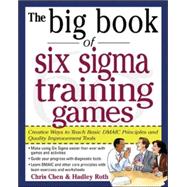
Note: Supplemental materials are not guaranteed with Rental or Used book purchases.
Purchase Benefits
What is included with this book?
Chris W. Chen is an organization effectiveness manager with Sempra Energy, a Fortune 500 company. He also runs his own consulting business, specializing in leadership training.
Hadley M. Roth is a Six Sigma Master Black Belt with Northrop Grumman Corporation, a $25 billion global defense company.
| Introduction | 1 | (6) | |||
|
7 | (28) | |||
|
8 | (4) | |||
|
8 | (4) | |||
|
12 | (6) | |||
|
12 | (3) | |||
|
15 | (3) | |||
|
18 | (13) | |||
|
18 | (13) | |||
|
31 | (4) | |||
|
31 | (4) | |||
|
35 | (22) | |||
|
36 | (6) | |||
|
36 | (3) | |||
|
39 | (3) | |||
|
42 | (6) | |||
|
42 | (2) | |||
|
44 | (4) | |||
|
48 | (9) | |||
|
48 | (6) | |||
|
54 | (3) | |||
|
57 | (28) | |||
|
59 | (8) | |||
|
59 | (8) | |||
|
67 | (8) | |||
|
67 | (8) | |||
|
75 | (7) | |||
|
75 | (5) | |||
|
80 | (2) | |||
|
82 | (3) | |||
|
82 | (3) | |||
|
85 | (32) | |||
|
86 | (9) | |||
|
86 | (5) | |||
|
91 | (4) | |||
|
95 | (7) | |||
|
95 | (7) | |||
|
102 | (6) | |||
|
102 | (6) | |||
|
108 | (3) | |||
|
108 | (3) | |||
|
111 | (6) | |||
|
111 | (6) | |||
|
117 | (42) | |||
|
118 | (3) | |||
|
118 | (3) | |||
|
121 | (5) | |||
|
121 | (5) | |||
|
126 | (33) | |||
|
126 | (19) | |||
|
145 | (14) | |||
|
159 | (24) | |||
|
160 | (4) | |||
|
160 | (4) | |||
|
164 | (4) | |||
|
164 | (4) | |||
|
168 | (12) | |||
|
168 | (12) | |||
|
180 | (3) | |||
|
180 | (3) | |||
|
183 | (18) | |||
|
184 | (7) | |||
|
184 | (4) | |||
|
188 | (3) | |||
|
191 | (10) | |||
|
191 | (5) | |||
|
196 | (5) | |||
|
201 | (16) | |||
|
201 | (2) | |||
|
203 | (3) | |||
|
206 | (2) | |||
|
208 | (6) | |||
|
214 | (3) | |||
|
217 | (16) | |||
|
217 | (5) | |||
|
222 | (3) | |||
|
225 | (4) | |||
|
229 | (4) | |||
|
233 | (14) | |||
|
233 | (4) | |||
|
237 | (2) | |||
|
239 | (3) | |||
|
242 | (5) | |||
| Index | 247 |
The New copy of this book will include any supplemental materials advertised. Please check the title of the book to determine if it should include any access cards, study guides, lab manuals, CDs, etc.
The Used, Rental and eBook copies of this book are not guaranteed to include any supplemental materials. Typically, only the book itself is included. This is true even if the title states it includes any access cards, study guides, lab manuals, CDs, etc.